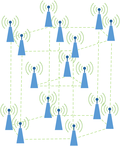Development of a High Spatial Resolution Sensor System for Monitoring Air Pollutants in Metropolitan Areas
WHO estimated that one in eight deaths worldwide in 2012 was due to the effects of air pollution. According to the European environment agency (EEA), 90% of European city residents are exposed to higher pollution concentrations exceeding the air quality standards. The three most harmful pollutants are nitrogen dioxide (NO2), ground level ozone (O3) and particulate matter (PM). In this project the possibility of large-scale monitoring of NO2 and PM in metropolitan areas, utilizing an intelligent sensorsystem is investigated. The focus will be laid on an increased spatial resolution, as compared to present sensor systems. To achieve this, we will implement newest developments on the Internet of Things (IoT) and energy harvesting.

